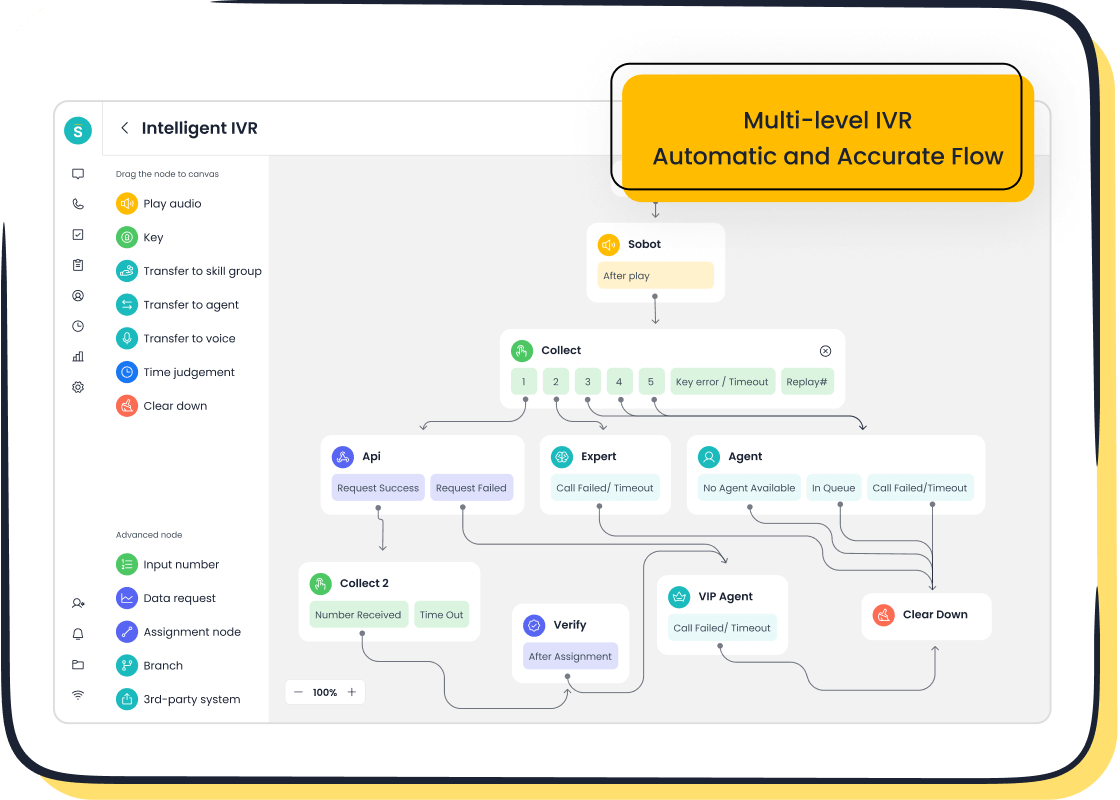Future Trends in Workforce Management for 2025 and Beyond


Workforce management (WFM) is reshaping how businesses tackle challenges and seize opportunities. Its transformative potential is evident in the numbers. The industry is projected to reach $9.93 billion by 2025, with companies saving an average of 7% on labor costs through WFM software. Moreover, organizations with advanced strategies are 2.7 times more likely to outperform their peers. These trends highlight the need for innovative approaches. Solutions like Sobot's Voice/Call Center empower businesses to optimize operations, enhance employee engagement, and stay ahead in a competitive landscape.
The Role of Technology in Workforce Management (WFM)

AI and Automation in Workforce Optimization
AI-driven scheduling and resource allocation
AI is revolutionizing workforce optimization by enabling smarter scheduling and resource allocation. For example, AI-powered tools analyze historical data to predict peak demand periods, ensuring the right number of employees are scheduled at the right time. Companies like Fluor Corporation have seen a 12% increase in labor productivity by using AI to match employee skills to project needs. This approach not only boosts efficiency but also enhances worker satisfaction. With 75% of workers now using AI, businesses that adopt these tools gain a competitive edge in managing their workforce.
Automation of repetitive tasks for efficiency
Automation eliminates repetitive tasks, freeing up employees to focus on higher-value activities. Tasks like data entry, payroll processing, and shift adjustments can be automated, reducing errors and saving time. Nearly 90% of users report that AI and automation save them time, with programmers completing 126% more projects weekly when using AI. By integrating automation into your WFM strategies, you can streamline operations and improve overall productivity.
Data Analytics for Workforce Insights
Predictive analytics for employee performance and retention
Predictive analytics transforms workforce management by providing actionable insights. For instance, companies using predictive analytics can anticipate over 75% of voluntary departures, enabling proactive retention strategies. One organization reduced turnover by 15% by identifying employees likely to leave and tailoring retention programs. These analytics also improve employee satisfaction, with some companies reporting a 30% improvement in engagement scores. By leveraging data, you can enhance both performance and retention.
Real-time data for decision-making

Real-time analytics empower managers to make informed decisions quickly. Mobile technology ensures data accessibility across devices, allowing immediate application of insights. Managers can optimize team performance, identify productivity bottlenecks, and adjust schedules on the fly. Tools like Sobot's Voice/Call Center provide real-time monitoring and analysis, helping businesses align workforce strategies with operational needs. This capability ensures agility in responding to dynamic workforce demands.
Cloud-Based WFM Tools
Scalability and accessibility benefits
Cloud-based WFM tools offer unmatched scalability and accessibility. These solutions reduce IT infrastructure costs by up to 35% and provide real-time data access across multiple locations. During the COVID-19 pandemic, cloud software adoption surged by 45%, highlighting its importance in modern workforce management. Procter & Gamble, for example, used cloud-based tools to optimize scheduling, achieving a 15% reduction in labor costs and a 30% productivity boost. With these tools, your workforce can adapt to changing demands effortlessly.
Integration with Sobot's Voice/Call Center for seamless operations

Sobot's Voice/Call Center exemplifies the power of cloud-based WFM tools. Its features, such as intelligent IVR and smart call routing, streamline communication and enhance workforce efficiency. The platform's global accessibility and 99.99% uptime ensure seamless operations, even for distributed teams. By integrating Sobot's solutions, you can unify workforce management processes and improve collaboration across your organization. Learn more about Sobot's Voice/Call Center here.
Employee-Centric Trends in Workforce Management
Enhancing Employee Engagement and Experience
Personalized career development and training
Investing in personalized career development programs can significantly boost employee engagement and retention. Employees value opportunities to grow their skills and advance their careers. For instance, 76% of employees are more likely to stay with a company that offers continuous training. Structured development programs also lead to a 56% increase in performance metrics and a 43% reduction in turnover. These benefits translate into substantial savings, with large organizations potentially saving $52 million annually by reducing attrition.
| Statistic | Description |
|---|---|
| 76% | Employees are more likely to stay with a company that offers continuous training. |
| 56% | Increase in employee performance when structured career development is implemented. |
| 43% | Lower turnover in stable organizations with development programs. |
By integrating tools like Sobot's Voice/Call Center, you can streamline training processes and provide employees with the resources they need to excel.
Leveraging feedback tools for continuous improvement
Feedback tools play a vital role in fostering engagement. Regular feedback helps employees understand their strengths and areas for improvement. Companies that implement feedback systems report higher satisfaction levels and improved team dynamics. Tools like AI-powered analytics can identify patterns in employee performance, enabling managers to tailor coaching sessions effectively. This approach not only enhances engagement but also creates opportunities for growth within your workforce.
Prioritizing Employee Well-Being
Wellness programs and mental health initiatives
Wellness programs are essential for maintaining a healthy and productive workforce. Taking time off reduces job stress by 59% and significantly improves satisfaction. Mental health initiatives, such as counseling services and stress management workshops, can further enhance well-being. Flexible work arrangements also allow employees to balance personal and professional responsibilities, contributing to overall happiness and engagement.
Flexible work arrangements to reduce burnout
Flexibility in work schedules has become a key trend in workforce management. It is linked to a 67% increase in job satisfaction. Employees with flexible arrangements can manage family needs and reduce burnout. For example, hybrid work models supported by tools like Sobot's Voice/Call Center ensure seamless communication, enabling employees to stay connected without compromising their well-being.
Inclusivity and Diversity in the Workforce
Strategies for fostering an inclusive culture
Creating an inclusive culture requires deliberate strategies. Employees who feel included report higher trust and engagement, which positively impacts workplace morale. Diverse teams also solve problems faster and produce higher-quality outcomes. Companies with inclusive cultures are 57.8% more likely to improve their reputations, making inclusivity a business imperative.
Technology's role in reducing bias in hiring and promotions
Technology can help reduce bias in hiring and promotions. AI-driven tools analyze candidate profiles objectively, ensuring fair evaluations. For example, Sobot's solutions integrate seamlessly with HR systems, enabling unbiased decision-making. By leveraging technology, you can create a more equitable workforce and unlock opportunities for innovation and growth.
The Evolution of Hybrid Work Models

Balancing Remote and On-Site Work
Tools like Sobot's Voice/Call Center for seamless collaboration

Hybrid working models have become a cornerstone of modern workforce management (WFM). To ensure seamless collaboration between remote and on-site employees, you need the right tools. Without them, employees may feel disconnected from the organization's culture, leading to impaired collaboration and strained relationships. Sobot's Voice/Call Center offers features like intelligent IVR and smart call routing, which unify communication channels. These tools allow your team to stay connected, regardless of location. With global number availability and 99.99% uptime, Sobot ensures uninterrupted communication, fostering a cohesive hybrid workforce.
Maintaining team cohesion and productivity
Balancing remote and on-site work requires strategies that promote both cohesion and productivity. Flexible employment models, such as allowing employees to set their own working hours, improve work-life balance and reduce burnout. Encouraging regular breaks and wellness programs also supports mental health. These trends have shown to increase productivity and mitigate burnout. For example, hybrid working models give employees control over their schedules, leading to higher satisfaction and efficiency. By adopting these practices, you can create a workforce that thrives in a hybrid environment.
Overcoming Challenges in Hybrid Work
Addressing communication gaps and time zone differences

Hybrid work introduces challenges like communication gaps and time zone differences. To address these, establish clear communication protocols. Define response times and preferred communication methods to ensure clarity. Promote a culture of transparency by sharing information openly and making decision-making processes accessible to all. Tools like Sobot's Voice/Call Center, with its time zone support and real-time monitoring, help bridge these gaps. Flexible work hours also accommodate diverse schedules, ensuring inclusivity. Training employees in virtual communication further enhances their ability to interpret digital cues effectively.
Ensuring equitable opportunities for all employees
Hybrid working models must prioritize equity. Remote employees often face disadvantages in visibility and opportunities. To counter this, conduct regular team-building activities that include both remote and on-site workers. Balance synchronous and asynchronous communication to cater to different working styles. By leveraging AI-powered tools, you can ensure unbiased evaluations in promotions and hiring. Sobot's solutions integrate seamlessly with HR systems, enabling fair assessments and fostering inclusivity. These strategies ensure that every employee, regardless of location, has equal access to growth opportunities.
Globalization and Workforce Dynamics
Managing Distributed Teams
Tools for effective cross-border communication

Managing distributed teams requires robust tools to ensure seamless communication across borders. Video conferencing platforms enable personal interactions, while instant messaging tools facilitate quick updates. Flexible work schedules also help accommodate different time zones, ensuring collaboration during overlapping hours. For example, fostering inclusivity through virtual events, such as cultural exchange sessions, strengthens team bonds. Sobot's Voice/Call Center supports global communication with features like time zone support and real-time monitoring, making it easier to manage distributed teams effectively.
Building a unified company culture
Building a unified culture in a distributed workforce involves celebrating diversity and promoting shared values. Organizing virtual team-building activities and recognizing achievements across regions fosters a sense of belonging. Adopting an outcomes-focused approach, where employees have autonomy in achieving their goals, builds trust. These strategies create a cohesive environment, enabling your workforce to thrive despite geographical barriers.
Navigating Legal and Compliance Challenges
Adapting to diverse labor laws and regulations
Global operations often face challenges in adhering to diverse labor laws. Approximately 60% of organizations report compliance issues, highlighting the need for effective solutions. Leveraging technology, such as integrated HR Management Systems, simplifies compliance by automating tasks like tracking certifications and regulatory updates. This approach reduces risks and ensures adherence to local laws, enabling smooth workforce management (WFM) across regions.
Ensuring fair compensation and benefits globally
Ensuring fair compensation globally requires understanding regional pay scales and benefits. Using data analytics tools helps you benchmark salaries and maintain equity. Sobot's solutions integrate seamlessly with HR systems, enabling accurate payroll management and compliance. By prioritizing fairness, you can attract top talent and foster employee satisfaction, driving long-term growth.
Leveraging Global Talent Pools
Accessing diverse skill sets for innovation
Global talent pools offer access to diverse skills and perspectives, driving innovation. Studies show that diverse teams solve problems more effectively and make better decisions. Inclusive environments encourage creativity and collaboration, leading to groundbreaking ideas. By embracing total talent management, you can unlock opportunities for growth and stay ahead of industry trends.
Overcoming recruitment and onboarding challenges
Recruiting and onboarding global talent involves navigating cultural differences and logistical hurdles. Streamlining these processes with AI-powered tools ensures efficiency. Sobot's Voice/Call Center supports onboarding by providing unified communication channels, enabling seamless integration of new hires. These strategies help you build a strong, diverse workforce ready to tackle future challenges.
Actionable Strategies for Future-Ready Workforce Management
Investing in Advanced WFM Technology
Identifying the right tools, including Sobot's Voice/Call Center
Choosing the right tools is essential for optimizing workforce management (WFM). Advanced WFM software can save up to 7% on labor costs and deliver an ROI of $12.24 for every dollar spent. Sobot's Voice/Call Center offers features like intelligent IVR and real-time monitoring, ensuring seamless communication and efficient operations. Its global accessibility and 99.99% uptime make it a reliable choice for businesses aiming to enhance productivity. By adopting such tools, you can reduce turnover rates by 20% and achieve significant annual cost savings.
| Evidence Description | Value |
|---|---|
| Average savings on labor costs | 7% |
| ROI for every dollar spent | $12.24 |
| Reduction in turnover rates | 20% |
Training employees to use new technologies effectively
Introducing new technologies requires proper training to maximize their benefits. Employees equipped with the right skills can use WFM software more efficiently, leading to better outcomes. For example, training programs that focus on Sobot's Voice/Call Center can help your team utilize features like smart call routing and AI-powered Voicebot effectively. This approach not only improves employee satisfaction but also ensures smooth adoption of technology across your organization.
Building a Resilient Workforce
Upskilling and reskilling for emerging roles
Technological advancements demand continuous skill development. Studies show that 54% of employees need significant upskilling due to rapid changes in technology. Companies investing in employee development report higher retention rates and reduced turnover costs. For instance, Sobot's solutions can support training initiatives by providing unified communication platforms that facilitate learning.
| Evidence | Description |
|---|---|
| Employee retention | Investment in employee development leads to higher retention rates and reduced turnover costs. |
| 54% of employees | Significant reskilling or upskilling needed due to technological changes. |
Encouraging a culture of continuous learning
A culture of learning fosters adaptability and innovation. In a survey, 75% of CEOs emphasized the importance of soft skills for future success. Encouraging employees to acquire new skills not only boosts their career growth but also strengthens your workforce. Tools like Sobot's Voice/Call Center can support this by enabling seamless collaboration and knowledge sharing.
Embracing Agility and Adaptability
Developing flexible workforce strategies
Flexible scheduling options improve job satisfaction and reduce stress. Research shows that changing schedules can decrease stress by 20% and increase satisfaction by 60%. Hybrid work models supported by tools like Sobot's Voice/Call Center ensure seamless communication, enabling employees to adapt to changing demands.
| Finding | Impact |
|---|---|
| Changing schedule | Decreased job stress by 20% |
| Changing schedule | Increased likelihood of job satisfaction by 60% |
Preparing for unforeseen challenges and opportunities
Agility in workforce management (WFM) prepares you for unexpected changes. Data-driven insights from WFM software help you make informed decisions quickly. For example, Sobot's real-time monitoring capabilities allow you to adjust strategies on the fly, ensuring your workforce remains productive and engaged during disruptions.
The future of workforce management (WFM) lies in embracing innovation, prioritizing employee engagement, and fostering adaptability. Trends like AI-driven analytics, hybrid work models, and global talent integration are reshaping how businesses operate. For example, predictive analytics can reduce turnover rates by 20%, while generational diversity boosts productivity by 15%.
| Statistic Description | Value | Source |
|---|---|---|
| Reduction in turnover rates with predictive analytics | 20% | Forbes |
| Higher productivity rates from generational diversity | 15% | Forbes |
Organizations that invest in employee engagement see measurable results, including a 23% increase in profitability and an 18% boost in productivity.

Adopting tools like Sobot's Voice/Call Center ensures seamless communication and operational efficiency. Its features, such as intelligent IVR and real-time monitoring, empower businesses to adapt to evolving workforce needs. By leveraging these strategies, you can stay competitive and build a resilient workforce for the future.
FAQ
What is workforce management (WFM), and why is it important?
Workforce management (WFM) involves optimizing employee scheduling, productivity, and engagement. It ensures businesses meet operational goals efficiently. For example, companies using WFM tools like Sobot's Voice/Call Center save up to 7% on labor costs while improving employee satisfaction and retention rates.
How does Sobot's Voice/Call Center enhance workforce management?
Sobot's Voice/Call Center streamlines communication with features like intelligent IVR, smart call routing, and real-time monitoring. These tools improve collaboration, reduce response times, and ensure seamless operations for hybrid and distributed teams. Its 99.99% uptime guarantees reliability, even during peak demands.
Can WFM tools help with employee retention?
Yes, predictive analytics in WFM tools identify employees at risk of leaving. For instance, businesses using such tools reduce turnover by 15%. Sobot's solutions integrate with HR systems, enabling proactive retention strategies and fostering a supportive work environment.
How do hybrid work models benefit from WFM tools?
Hybrid models thrive with WFM tools that bridge communication gaps. Sobot's Voice/Call Center supports global teams with time zone features and unified communication channels. These capabilities ensure team cohesion and productivity, regardless of location.
Are cloud-based WFM tools secure and scalable?
Cloud-based WFM tools, like Sobot's Voice/Call Center, offer encrypted data transfer and global scalability. They reduce IT costs by 35% and adapt to growing workforce needs. Their accessibility ensures seamless operations across multiple locations.
See Also
Best Cloud Contact Center Solutions to Consider in 2024
Comprehensive Reviews of Leading Contact Center Solutions for 2024
Best 10 Call Center Analytics Tools to Use in 2024
